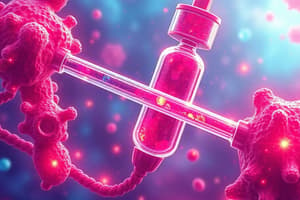Podcast
Questions and Answers
¿Qué médico fue el primero en utilizar el término 'diabetes mellitus'?
¿Qué médico fue el primero en utilizar el término 'diabetes mellitus'?
- Leonard Thompson
- Thomas Wills (correct)
- Areteo de Capadocia
- Banting y Best
La diabetes mellitus fue reconocida por primera vez en el año 1500 d.C.
La diabetes mellitus fue reconocida por primera vez en el año 1500 d.C.
False (B)
¿Quiénes descubrieron la insulina por primera vez?
¿Quiénes descubrieron la insulina por primera vez?
Banting y Best
El __________ es el órgano donde se producen las células que secretan insulina.
El __________ es el órgano donde se producen las células que secretan insulina.
Empareja las siguientes hormonas con su función:
Empareja las siguientes hormonas con su función:
¿Cuál es la función principal de la insulina?
¿Cuál es la función principal de la insulina?
Los islotes de Langerhans representan el 95-99% del páncreas.
Los islotes de Langerhans representan el 95-99% del páncreas.
¿Qué relación tiene el páncreas con el duodeno?
¿Qué relación tiene el páncreas con el duodeno?
¿Qué hormona es producida por las células beta del páncreas?
¿Qué hormona es producida por las células beta del páncreas?
La diabetes mellitus tipo 1 es más común en adultos que en niños.
La diabetes mellitus tipo 1 es más común en adultos que en niños.
¿Qué características son utilizadas para diagnosticar la diabetes mellitus tipo 2?
¿Qué características son utilizadas para diagnosticar la diabetes mellitus tipo 2?
La diabetes mellitus tipo 2 está relacionada con la ______ a la insulina.
La diabetes mellitus tipo 2 está relacionada con la ______ a la insulina.
Emparejar los tipos de diabetes con su principal característica:
Emparejar los tipos de diabetes con su principal característica:
¿Cuál es el método más común utilizado para diagnosticar resistencia a la insulina?
¿Cuál es el método más común utilizado para diagnosticar resistencia a la insulina?
El tratamiento para la diabetes tipo 1 incluye el uso de insulina.
El tratamiento para la diabetes tipo 1 incluye el uso de insulina.
¿Qué efecto tiene la glucosa elevada en el cuerpo que se menciona en la clínica de diabetes?
¿Qué efecto tiene la glucosa elevada en el cuerpo que se menciona en la clínica de diabetes?
Los síntomas de la diabetes pueden resumirse en las 4 P's: Poliuria, Polidipsia, Polifagia y ______.
Los síntomas de la diabetes pueden resumirse en las 4 P's: Poliuria, Polidipsia, Polifagia y ______.
Emparejar las clases de medicamentos con su función:
Emparejar las clases de medicamentos con su función:
¿Cuál de las siguientes afirmaciones sobre la Diabetes Mellitus tipo 2 es verdadera?
¿Cuál de las siguientes afirmaciones sobre la Diabetes Mellitus tipo 2 es verdadera?
La acantosis nigricans es un signo común en personas con diabetes mellitus tipo 2.
La acantosis nigricans es un signo común en personas con diabetes mellitus tipo 2.
¿Qué grupo de hormonas actúa como contrarreguladores de la insulina?
¿Qué grupo de hormonas actúa como contrarreguladores de la insulina?
La hemoglobina A1C se utiliza para el diagnóstico de diabetes si el nivel es superior a ______ %
La hemoglobina A1C se utiliza para el diagnóstico de diabetes si el nivel es superior a ______ %
Flashcards
Diabetes Mellitus (DM)
Diabetes Mellitus (DM)
Una enfermedad en la que el cuerpo no puede regular adecuadamente los niveles de azúcar en la sangre.
Insulina
Insulina
Hormona producida por las células beta del páncreas que ayuda a reducir los niveles de azúcar en la sangre.
Glucagón
Glucagón
Hormona producida por el páncreas que aumenta los niveles de azúcar en la sangre.
Islotes de Langerhans
Islotes de Langerhans
Signup and view all the flashcards
Hiperglucemia
Hiperglucemia
Signup and view all the flashcards
Hipoglucemia
Hipoglucemia
Signup and view all the flashcards
Páncreas
Páncreas
Signup and view all the flashcards
GLUT-2
GLUT-2
Signup and view all the flashcards
Diabetes Mellitus Tipo 1 (DM1)
Diabetes Mellitus Tipo 1 (DM1)
Signup and view all the flashcards
Diabetes Mellitus Tipo 2 (DM2)
Diabetes Mellitus Tipo 2 (DM2)
Signup and view all the flashcards
Resistencia a la insulina
Resistencia a la insulina
Signup and view all the flashcards
Síntomas de la diabetes (4P's)
Síntomas de la diabetes (4P's)
Signup and view all the flashcards
Diagnóstico de diabetes
Diagnóstico de diabetes
Signup and view all the flashcards
Tratamiento de la DM2
Tratamiento de la DM2
Signup and view all the flashcards
Tratamiento de la DM1
Tratamiento de la DM1
Signup and view all the flashcards
Autoinmunidad
Autoinmunidad
Signup and view all the flashcards
Tipos de insulina
Tipos de insulina
Signup and view all the flashcards
HOMA-IR
HOMA-IR
Signup and view all the flashcards
Amilina
Amilina
Signup and view all the flashcards
Study Notes
Diabetes Mellitus
- History: First documented in 1500 BCE; Areteo of Cappadocia described diabetes as a condition characterized by excessive urination.
- Early Research: Numerous researchers contributed to understanding diabetes, including those who worked on isolating pancreatic extracts and reducing glycemia in depancreatized dogs.
- Key Discoveries: Banting and Best discovered insulin; it was later purified and applied to Leonard Thompson in 1922, marking the first insulin treatment.
Cellular Populations in the Pancreas
- Cell Types: The pancreas contains different cell types within the islets of Langerhans, including alpha, beta, delta, and PP cells.
- Cell Function: Alpha cells produce glucagon; beta cells produce insulin.
- Hormonal Regulation: Glucagon is released in response to hypoglycemia, while insulin is released in response to hyperglycemia, maintaining blood glucose homeostasis.
Insulin and the Body
-
Insulin Types: Different types of insulin include rapid-acting and long-acting, each having different absorption rates.
-
C-Peptide: C-peptide is also produced during insulin synthesis and secretion
-
Action of Insulin: Insulin's role is crucial in bringing glucose into certain cells like muscle and fat cells. It also lowers blood glucose levels
Anatomy and Physiology of the Pancreas
- Pancreatic Anatomy: The pancreas is a retroperitoneal organ extending approximately 14-20cm in length.
- Exocrine Function: The exocrine portion of the pancreas produces digestive enzymes.
- Endocrine Function: The endocrine portion, comprised of islets of Langerhans, produces hormones like insulin and glucagon.
Diabetes Classification
- Major Types: Type 1 Diabetes (insulin-dependent diabetes) and Type 2 Diabetes (non-insulin-dependent diabetes) are the most common forms.
- Prevalence: Type 2 diabetes is significantly more common, usually occurring in individuals over 45 years old.
Diabetes Mellitus Type 2
- Etiology: Predominantly caused by insulin resistance and defects in insulin secretion.
- Risk Factors: Obesity is frequently linked to Type 2 diabetes, along with other factors such as sedentary lifestyle and genetics.
- Treatment: Weight loss, exercise, and medication including oral hypoglycemic agents are often part of the management plan.
Diagnostic Tools
- Diagnosis: Blood tests (HbA1c, fasting glucose, oral glucose tolerance test) are vital in properly diagnosing diabetes.
- Key Tests: Testing for C-peptide, autoantibodies, and other relevant factors plays an important role in diagnosing and classifying type of diabetes.
Studying That Suits You
Use AI to generate personalized quizzes and flashcards to suit your learning preferences.




